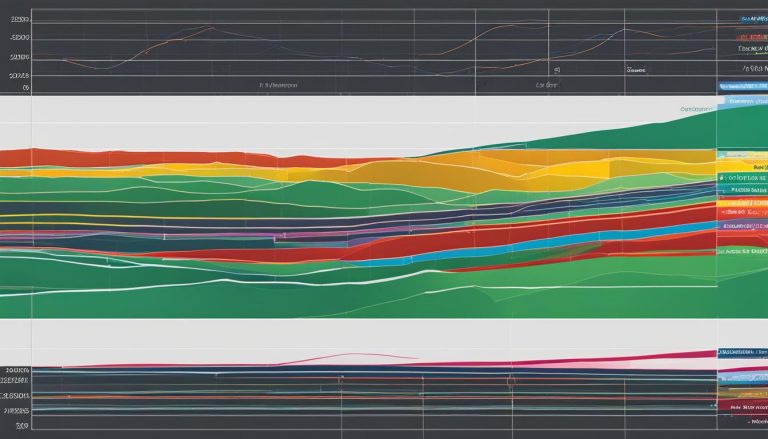A support vector machine (SVM) is a supervised machine learning model that is used for classification problems. It is fast and dependable, making it suitable for analyzing limited amounts of data. SVMs are especially useful for text classification tasks in natural language processing (NLP). They have higher speed and better performance with a limited number of samples compared to newer algorithms like neural networks.
SVMs work by finding a hyperplane that separates the data into two classes. The hyperplane is the decision boundary, and its position is determined by maximizing the margins from the support vectors, which are the data points closest to the hyperplane. SVMs can handle linearly separable data as well as non-linear data by using a kernel trick to transform the data into a higher-dimensional space.
SVMs are commonly used in various fields, such as natural language classification, image recognition, and handwritten digit recognition.
Key Takeaways:
- Support Vector Machines (SVM) is a supervised machine learning model used for classification
- SVMs are particularly useful for text classification tasks in NLP
- SVMs find a hyperplane that separates data into classes by maximizing margins from support vectors
- SVMs can handle both linearly separable and non-linear data by using a kernel trick
- SVMs are commonly used in natural language classification, image recognition, and handwritten digit recognition
How Does SVM Work?
SVM works by finding a hyperplane that separates data into different classes. The hyperplane is the decision boundary, and it is determined by maximizing the margins from the support vectors. Support vectors are the data points that are closest to the hyperplane and play a crucial role in defining the decision boundary. The margin is the distance between the hyperplane and the nearest support vector from each class. SVM aims to find the hyperplane with the largest margin, as it provides a better chance of correctly classifying new data.
In the case of linearly separable data, the hyperplane is a line. However, for non-linear data, SVM uses the kernel trick to map the data into a higher-dimensional space where it becomes linearly separable. After the classification boundary is determined, SVM can predict the class of new unlabeled data based on its position relative to the decision boundary.
SVM’s ability to classify data accurately and efficiently has made it a widely used algorithm in various applications. By understanding how SVM works, we can leverage its power in solving classification problems and unlocking insights from our data.
Using SVM with Natural Language Classification
Support Vector Machines (SVM) can be incredibly powerful when applied to natural language classification tasks. SVM can help in tasks such as text categorization, sentiment analysis, and spam detection by transforming text data into numeric feature vectors. One common approach is to use word frequencies as features, where each word in the text becomes a feature with its frequency determining its value.
In natural language processing (NLP), the training data for SVM consists of labeled texts represented as feature vectors. Various preprocessing techniques like stemming, removing stopwords, and using n-grams can be applied to enhance the accuracy of SVM in NLP tasks. Additionally, other feature extraction techniques like TF-IDF can also be used to calculate the values of features.
The choice of the kernel function in SVM is crucial for achieving optimal performance in natural language classification. Linear kernels are commonly used in NLP as they work well with high-dimensional feature spaces. By leveraging the power of SVM and suitable preprocessing techniques, NLP practitioners can effectively classify and analyze large amounts of text data.
Table: SVM in Natural Language Classification
| Feature Extraction Techniques | Kernel Function | Use Case |
|---|---|---|
| Word Frequencies | Linear Kernel | Text Categorization |
| TF-IDF | Linear Kernel | Sentiment Analysis |
| Preprocessed Text | RBF Kernel | Spam Detection |
Simple SVM Classifier Tutorial
Creating an SVM classifier doesn’t have to be complicated. There are user-friendly tools, like MonkeyLearn, that allow you to create an SVM classifier without coding or dealing with vectors and kernels. MonkeyLearn provides a code-free platform where you can create your own SVM classifier in just a few simple steps.
To create an SVM classifier with MonkeyLearn, you need to sign up for a free account. Then, you can create a new classifier and select the type of classification you want. You can import your training data, define the tags for your SVM classifier, and start training it.
Once the SVM classifier is trained, you can use it to predict the class of new unlabeled data by providing the text as input. MonkeyLearn’s intuitive user interface and no-code approach make it easy to create and use SVM classifiers without investing a large amount of time and resources.
Step-by-Step Guide to Creating an SVM Classifier with MonkeyLearn
- Sign up for a free MonkeyLearn account.
- Create a new classifier and select the type of classification you want.
- Import your training data and define the tags for your SVM classifier.
- Start training your SVM classifier.
- Once trained, you can use your SVM classifier to predict the class of new unlabeled data.
By following these simple steps, you can quickly create and deploy an SVM classifier without the need for any coding or complex algorithms. MonkeyLearn’s user-friendly platform makes it accessible to users of all skill levels, allowing you to harness the power of SVM for your classification tasks.
Theory Behind Support Vector Machines
In order to understand the theory behind Support Vector Machines (SVM), it’s important to grasp the concept of the hyperplane. The SVM aims to find a hyperplane that effectively separates data into different classes. This hyperplane is determined by identifying the support vectors, which are data points that are closest to the hyperplane. By maximizing the margin between the hyperplane and the support vectors, SVM achieves better separation of classes.
The process of finding the optimal hyperplane involves an optimization problem, where SVM aims to minimize the classification error and maximize the margin. The decision boundary, which is determined based on the support vectors, is what allows SVM to classify new data points. The position of a new data point relative to the decision boundary determines its class.
SVM can handle both linearly separable and non-linearly separable data. For non-linear data, SVM utilizes kernel functions to map the data into higher-dimensional spaces, where it becomes linearly separable. This allows SVM to solve classification problems that would otherwise be difficult for linear classifiers. By finding the optimal hyperplane and effectively separating classes, SVM is able to generalize well to new, unseen data.
SVM Optimization Problem
The optimization problem in SVM involves finding the hyperplane that maximizes the margin between classes while minimizing the classification error. In mathematical terms, this can be represented as:
minimize: wTw + C * Σi=1N ξi
subject to: yi(wTxi + b) ≥ 1 – ξi
where:
- w is the weight vector
- C is the regularization parameter
- xi are the input vectors
- yi are the corresponding class labels
- b is the bias term
- ξi are slack variables
This optimization problem ensures that the hyperplane separates the classes as widely as possible, with minimal misclassification. The value of the regularization parameter C determines the tradeoff between maximizing the margin and minimizing the classification error. A smaller value of C emphasizes a wider margin, while a larger value of C allows more misclassifications but leads to a tighter margin.
| SVM | Support Vectors | Separation of Classes |
|---|---|---|
| Maximizes the margin | Determines the hyperplane | Ensures accurate classification |
| Handles linear and non-linear data | Identifies data points closest to the hyperplane | Achieves better separation of classes |
| Uses kernel functions | Maps data into higher-dimensional spaces | Handles non-linearly separable data |
| Generalizes well to new data | Determines decision boundary | Classifies new data points |
Pros and Cons of Support Vector Machines
Support Vector Machines (SVMs) have gained popularity in the field of machine learning due to their unique characteristics and capabilities. Like any other algorithm, SVMs come with their own set of advantages and disadvantages, which are important to consider when deciding whether to use them for a specific task. Let’s explore the pros and cons of SVMs in detail.
Advantages of SVM
- Accuracy: SVMs are known for their high accuracy in classification tasks, especially when dealing with limited amounts of data. They have a strong generalization capability, which means they can effectively classify new, unseen data based on training patterns.
- Performance: SVMs perform well when working with smaller, cleaner datasets. They are faster and more efficient compared to other algorithms, thanks to their ability to use a subset of training points called support vectors. This makes SVMs particularly suitable for scenarios where computational resources are limited.
Disadvantages of SVM
- Training Time: SVMs can be computationally expensive, especially when dealing with larger datasets. The training time increases significantly as the number of training samples increases. This makes SVMs less suitable for tasks that involve big data or real-time processing.
- Noisier Datasets: SVMs are sensitive to noisy datasets with overlapping classes. If the classes in the dataset are not well-separated, SVMs may struggle to find an optimal decision boundary. In such cases, other algorithms like decision trees or random forests may be more suitable.
- Parameter Tuning: SVMs require careful parameter tuning to achieve optimal performance. The choice of parameters, such as C and gamma, significantly impacts the accuracy and generalization capability of the model. Improper tuning may result in overfitting or underfitting, affecting the overall performance of the SVM.
Despite their limitations, SVMs remain a powerful machine learning algorithm that has been successfully applied in various domains. They are particularly useful in tasks such as text classification, image recognition, and handwriting recognition. By weighing the pros and cons, you can make an informed decision on whether SVMs are the right choice for your specific application.
SVM Applications and Use Cases
Support Vector Machines (SVMs) find application in various domains and use cases. This versatile machine learning algorithm has proven to be effective in solving classification problems across different fields. Let’s explore some of the key applications and use cases of SVM:
Text Classification
SVM is widely used in text classification tasks such as topic classification, sentiment analysis, and spam detection. By transforming text data into numeric feature vectors, SVM can effectively categorize and analyze large volumes of textual data. This makes it a valuable tool for applications in natural language processing and information retrieval.
Image Recognition and Computer Vision
SVMs have demonstrated strong performance in image recognition challenges. They are particularly effective in aspect-based recognition and color-based classification tasks. SVMs can classify images based on specific features or characteristics, enabling applications in computer vision, object detection, and image-based decision-making systems.
Handwritten Digit Recognition
SVMs have been extensively used in the recognition of handwritten digits, contributing to applications in postal automation services and optical character recognition (OCR) systems. By training on large datasets of handwritten digits, SVMs can accurately classify and interpret handwritten characters, enabling automation and digitized document processing.
| SVM Applications | Use Cases |
|---|---|
| Text Classification |
|
| Image Recognition |
|
| Handwritten Digit Recognition |
|
SVM’s ability to handle both linearly separable and non-linearly separable data, along with its flexibility in using different kernel functions, makes it a powerful tool for solving complex classification problems. With its wide range of applications and use cases, SVM continues to be a valuable algorithm in the field of machine learning and pattern recognition.
Conclusion
In summary, Support Vector Machines (SVMs) are powerful supervised machine learning models that excel at classification tasks. SVMs work by finding a hyperplane that separates data into different classes, using support vectors and maximizing the margin. They can handle both linearly separable and non-linearly separable data thanks to the kernel trick, which maps the data into higher-dimensional spaces.
SVMs offer advantages in terms of accuracy and performance when working with limited amounts of data. However, they may not be the best choice for larger datasets or datasets with overlapping classes. Careful parameter tuning is necessary to achieve optimal performance. Despite their limitations, SVMs have found success in various applications, including natural language classification and image recognition.
In conclusion, SVM is a powerful machine learning algorithm that has proven to be effective in solving classification problems in different fields. Its ability to handle both linearly separable and nonlinearly separable data, along with its accuracy and efficiency, makes it a valuable tool for data analysis and pattern recognition.
FAQ
What is Support Vector Machines (SVM)?
Support Vector Machines (SVM) is a supervised machine learning model used for classification problems. It works by finding a hyperplane that separates data into different classes.
How does SVM work?
SVM works by identifying support vectors, which are the data points closest to the hyperplane. It aims to maximize the margin between the hyperplane and the support vectors for better separation of classes.
How can SVM be used with natural language classification?
SVM can be used with natural language classification by transforming text data into numeric feature vectors. Techniques like word frequencies and TF-IDF can be used to calculate feature values.
How can I create a simple SVM classifier?
You can create a simple SVM classifier using user-friendly tools like MonkeyLearn. It allows you to create an SVM classifier without coding or dealing with vectors and kernels.
What is the theory behind Support Vector Machines?
The theory behind Support Vector Machines involves finding a hyperplane that separates data into different classes and maximizing the margin between the hyperplane and the support vectors.
What are the pros and cons of Support Vector Machines?
Some advantages of SVM include accuracy, efficiency with limited data, and suitability for smaller, cleaner datasets. However, SVMs may not be suitable for larger datasets or datasets with overlapping classes.
What are some applications and use cases of Support Vector Machines?
SVM is commonly used in text classification, image recognition, and handwritten digit recognition tasks.
Cathy is a senior blogger and editor in chief at text-center.com.


